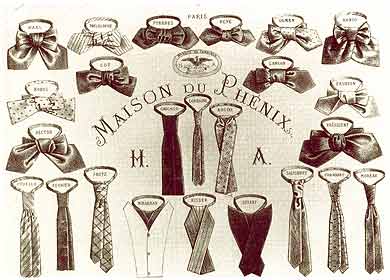The first word that I learnt from this research – sartorialists – derived from the word Sartorial (adj) that of or relating to clothing or style or manner of dress.
Textured, solid, striped, botanical, jacquard, geometric, 52 to 58 inches long, alternately withering or widening from 3112 to 5 inches, costing anywhere from three for $10 to $100 or more.
Why has this apparently useless piece of silk, or wool, or rayon, or polyester or even rubber (yes, there are Rubber-Necker Ties, “a recycled fashion statement for the eco-executive”) survived the swings of fashion for more than three centuries? Why is it still fit to be tied?
Fashion observers say the necktie survives because it is the one formal accessory in the male wardrobe that expresses personality, mood or inner character. The tie is that splash of color, that distinctive pattern, that statement of individuality that a man can make in the world of uniform pinstripes and plaids.
The tie has been seen as a form of male chest display, recalling the chest-pounding and puffing of our prehistoric ancestors. Or it can be viewed as the noose around the neck of the conformist white-collar worker, or the symbolic leash held by women who purchased more than 50 percent of the 105 million ties sold in the United States last year. Although most American men do not wear ties daily, U.S. neckware sales totaled $1.6 billion last year, with 70 percent made by American companies.
The necktie originated in the 17th century, during the 30 year war in France. King Louis XIII hired Croatian mercenaries who wore a piece of cloth around their neck as part of their uniform. While these early neckties did serve a function (tying the top of their jackets that is), they also had quite a decorative effect – a look that King Louis was quite fond of. In fact, he liked it so much that he made these ties a mandatory accessory for Royal gatherings, and – to honor the Croatian soldiers – he gave this clothing piece the name “La Cravate” – the name for necktie in French to this day.
International Necktie Day is celebrated on October 18 in Croatia and in various cities around the world, including in Dublin, Tübingen, Como, Tokyo, Sydney and other town
The Evolution of Modern Necktie

The early cravats of the 17th century have little resemblance to today’s necktie, yet it was a style that stayed popular throughout Europe for over 200 years. The tie as we know it today did not emerge until the 1920s but since then has undergone many (often subtle) changes.
In the 2nd century A.D., Roman legionnaires probably didn’t think of themselves as reflecting a trend when they tied bands of cloth around their necks. Most likely, they were just looking for protection from the weather.
Some historians have called the legionnaires’ adornments the first neckwear. But others cite the excavation near the Chinese city of Xi’an of 3rd century B.C. terra-cotta statues of warriors who wore neck scarves in the belief that they were protecting the source of their strength, their Adam’s apples.
Most experts, however, date the initial appearance of the modern precursor of the tie to 1636. Croatian mercenaries, hired in Paris by King Louis XIV, wore cloth bands around their necks to ward off natural elements, which in their line of work included sword slashes.
Parisians quickly translated the Croats’ scarf into a new clothing accessory, and, voila!, the cravate was born. The French term cravate is derived from Croates, French for Croatian. Not to be outdone, the English adapted the cravat, dropping the final “e”, and the American colonies soon stepped in line.
Once launched, the cravat and its styles and knots proliferated. Early cravats looked like lace bibs with bows backing them up, some reaching two yards in length.
Among emerging varieties in the late 17th century was the Steinkirk, a corkscrew-like wrap, originating from the Battle of Steinkirk where startled French officers hastily twisted their ties as they fled their tents to turn back the British onslaught.
During the early 18th century and into the 19th century, cravats had major competition: the stock. While a cravat generally was a long piece of cloth that wound around the neck and tied in front, the stock resembled collars worn today for whiplash or other neck injuries.
Made of muslin, sometimes with cardboard stiffeners inside, stocks were fastened in back by a hook or knot. In front, they had what looked like a pretied bowtie or sometimes a wide cravat covering the stock and swathing the neck like a poultice. Stocks forced men to stand upright in a stiff posture.
American revolutionaries George Washington, Thomas Jefferson and the Adamses (John and John Quincy) can be seen in contemporary portraits by Gilbert Stuart and Charles Willson Peale, wearing swath-like cravats, although the American versions were less radical than those of their counterparts in France.
In the mid-1800s, the “solitaire” appeared — attached to the wig in the back, wrapped around the neck and brought to a bow in the front over a cravat.
Some other bizarre dress and tie styles emerged in the mid-18th century. In England, the so-called “Macaronis” were dandies affecting an Italian style, coloring their cheeks with rouge and wearing diamond-studded pumps and cravats with huge bows. The fashion may be alluded to in the lyrics to “Yankee Doodle Dandy.”

